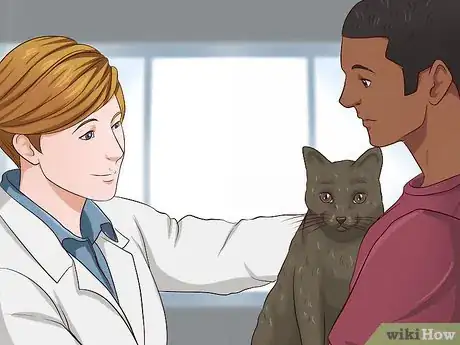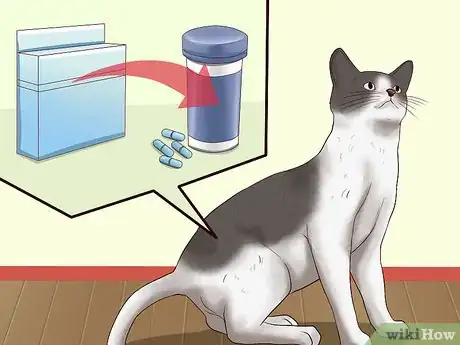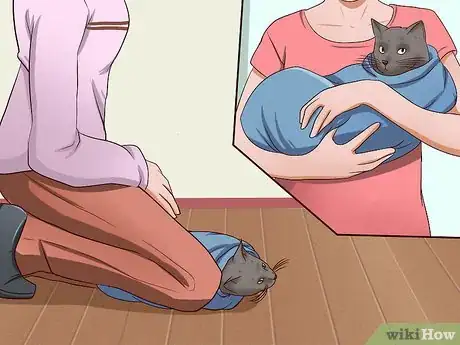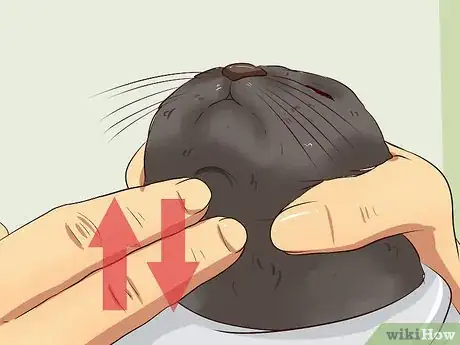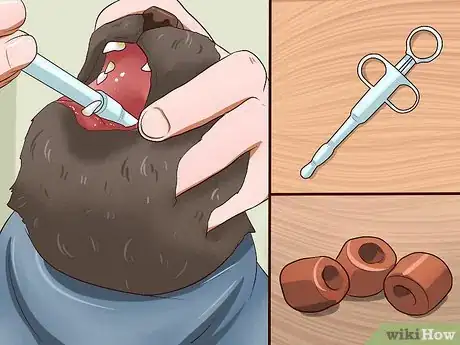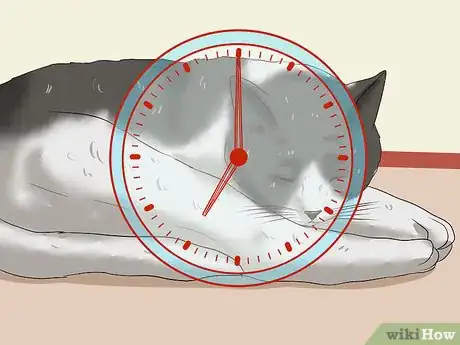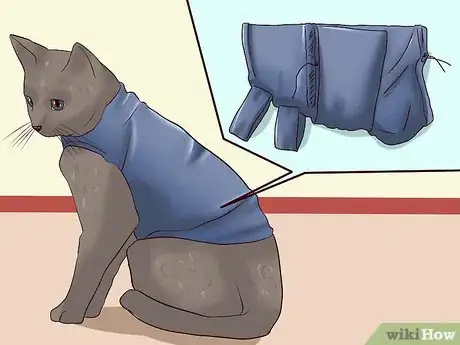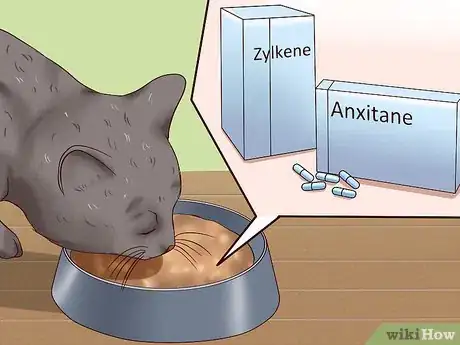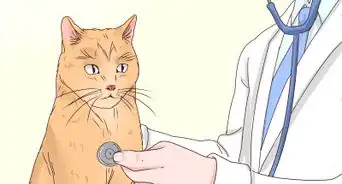This article was co-authored by Pippa Elliott, MRCVS. Dr. Elliott, BVMS, MRCVS is a veterinarian with over 30 years of experience in veterinary surgery and companion animal practice. She graduated from the University of Glasgow in 1987 with a degree in veterinary medicine and surgery. She has worked at the same animal clinic in her hometown for over 20 years.
There are 11 references cited in this article, which can be found at the bottom of the page.
This article has been viewed 357,721 times.
There are a variety of reasons you may need to sedate your cat. Perhaps your pet doesn't travel well or gets stressed out by vet exams or professional grooming. There are many ways to calm down your cat in stressful situations — some medical and some non-medical. Do your research on all methods to determine which will be best for your pet.
Steps
Choosing a Medication
-
1Seek a veterinarian's advice. For most sedatives, you'll need a prescription from a veterinarian anyway. Even if you're buying an over-the-counter medication, run it by your vet to make sure he or she approves of it — a poor quality product could be dangerous to your pet's health. All animals that are going to be medically sedated should be examined by a vet before use to make sure they're healthy enough for sedation.
- Tell your veterinarian if you plan on flying with a sedated cat. The combination of air pressure, elevation, and excessive stress can cause adverse reactions that can prove potentially fatal.[1]
-
2Discuss time frames with your vet. Different medications take different amounts of time to kick in, so you want to know how your particular medication works. Ask your veterinarian how far ahead of time you should administer the medication before the event that will stress out your cat. Some medications may kick in almost immediately, while others may take up to an hour to be effective.
- With medications that take time to kick in, the cat's anxiety may override the sedative if you don't allow it to go into effect in a relaxed environment.
Advertisement -
3Familiarize yourself with the types of sedative medication. There are many different types of medications used for sedating cats. All of the medications discussed here require a vet exam and prescription. Discuss your options with your vet to figure out which one is best for your pet. The vet will use his education, training and experience to recommend the medication with the least side effects and risk for your pet.
- Benzodiazepines are a popular sedative that can reduce anxiety almost immediately. Side effects include disorientation, sleeplessness, and increased appetite. They should be used with extreme caution in cats with liver or kidney problems.
- SARIs also relieve anxiety rapidly, but can cause slight dizziness and disorientation. They should be used with caution in animals with heart conditions.
- Clonidine and gabapentin were developed to treat blood pressure and nerve pain in humans, but have sedative and anti-anxiety effects in animals.
- Chlorpheniramine is an allergy and cold medication, while phenobarbital is a narcotic and sedative used to treat epilepsy.
-
4Do not expect a quick fix. There are a wide variety of medications available to sedate a cat, most of which must be prescribed by a vet. However, just like with humans, individual cats can have different responses to different medications.[2] What works well on one cat might not work well on another. Plan for medicated sedation as far ahead of time as possible so you can adjust the medication as necessary. Don't expect a "magic pill" that will work instantly.
Using Medication to Sedate Your Cat
-
1Perform a trial run. You should always do a trial run with the medication before you actually need to sedate your cat. This ensures that she responds well to it; otherwise, your pet may have a bad reaction in an already stressful situation. In general, you should give yourself at least a week of wiggle room, so you can revisit your vet and discuss other options if your first choice medication is ineffective.
- Wait for a time when both you and your cat are calm and relaxed.
- After giving her the medication, observe her for 12 hours to gauge her reaction to it.
- The cat should be relaxed and calm, but not woozy or unconscious.[3] If she appears disoriented or panicked, do not use that medication again.
-
2Prepare your cat for sedation. Make sure you're within the time frame for sedation you discussed with your vet. Give the medication time to kick in before the stressful event. Both you and the cat should be as relaxed as possible.
- Wrap the cat in a small blanket, pillowcase, or towel with only her head exposed.
- Hold her on the floor straddled between your legs or on your lap, or have someone hold the cat for you.
-
3Give your cat her medication.[4] Make sure to follow your vet's dosage instructions carefully. These powerful medications can prove harmful if used inaccurately.
- Put your thumb on one side of the cat's mouth, and your forefinger on the
- Apply gentle pressure until your cat opens her mouth.
- With your free hand, press gently down on the lower jaw to further open the mouth.
- Pop in the pill or squeeze liquid medication into the inside of the mouth on the side of 1 cheek.
-
4Make sure the cat swallows the medication.[5] While keeping her body firmly secured, release her mouth from your hands. Lift her face so her nose points upward, and gently rub her throat to encourage her to swallow. You might also blow gently in her face, which make her gulp or swallow. Stay in this position for a few seconds before removing the coverings and releasing the cat.
- If you see the cat licking her nose, that’s a sign she’s probably swallowed the medicine.
- Give your cat a lot of praise for her good behavior, and comfort her if she's upset about what just happened.
-
5Use alternate delivery methods if needed.[6] Taking oral medication doesn't feel natural to cats, and yours may fight back when you try to sedate her. It may help to wrap your cat snugly in a towel while administering the sedative. When she's swaddled like a baby, she won't be able to struggle as much and get away.
- You can buy "pill guns" that let you drop the pill toward the back of the cat's mouth, raising the odds of her swallowing it.
- Try wrapping the pill in a little bit of cheese or other treat your cat enjoys to sneak it to her.
- Ask the veterinarian for liquid medication if you have trouble administering pills.
- Ask the vet before trying to mix liquid sedative into the cat's wet food. You want to make sure it won't render the drug ineffective.
-
6Wait for the sedative to kick in.[7] Different medications and dosages take different lengths of time to take effect. Your veterinarian will let you know how long your specific medication and dosage should take to kick in, and how long it should be effective. In general, though, you're looking for your cat to become groggy and tired, but not disoriented and confused. The cat should be restful, but not lose consciousness suddenly. Some cats fall asleep entirely, while others stay awake, but quiet and calm.
- Your cat may be back to normal after just a few hours, or she may seem drowsy for the next couple days.[8]
- If, after a couple days, she’s still not back to normal, contact your veterinarian.
Using Non-Medication Sedation Methods
-
1Use synthetic pheromones in your home.[9] If your cat is anxious, overexcited, or displays unwanted behaviors like scent marking or scratching, synthetic pheromones are a good solution. These chemicals mimic the pheromones that cats naturally produce to communicate with other cats. A few companies have used essential oils or herbal blends to mimic pheromones.[10] Regular use can make cats feel calmer and more secure at home.
- Synthetic pheromones can be used as collars, sprays, wipes, or plug-in diffusers.
- Popular brands include Feliway, Comfort Zone, and Sergeant’s Pet Care, among others.[11]
- You can use them all the time to keep your cat happy and calm. You may also introduce them a few weeks before a stressful event to prepare her for it.
-
2Consider using body wraps. Body wraps have proven to be helpful in relieving anxiety in cats. These products wrap around the cat’s torso, applying gentle pressure on her pressure points. The effect is similar to that of swaddling an infant. Though these products are more well-known for use in dogs, they are just as effective in cats.
-
3Towel wrap her if you don’t have a body wrap.[12] If you haven’t invested in a body wrap and your cat is anxious or fearful, you can mimic the effect using a heavy towel. Wrap the cat in the towel so her entire body is covered, except for her face. Make sure the towel is wrapped snugly around her body. This method can be used if you need to give her medication, trim her nails, or do anything that might upset her for a short period of time.
- Always make sure to praise the cat after releasing her from the towel.
-
4Try using food supplements to combat anxiety. The ingredients in these supplements support the cat’s natural chemical balance to improve relaxation. They may come in liquid, chew, or tablet forms. Two examples of supplements include Anxitane and Zylkene.
- Anxitane is a green tea amino acid which (according to the manufacturer) works on chemical receptors in the brain to reduce fear and anxiety in cats.
- Zylkene is a supplement derived from the milk protein that helps soothe newborns.[13]
- You can buy these supplements online or at a vet's office.
Expert Q&A
Did you know you can get expert answers for this article?
Unlock expert answers by supporting wikiHow
-
QuestionMy 18-year-old cat is extremely vocal at night, and she wakes me every 3 hours. What can I do?
 Pippa Elliott, MRCVSDr. Elliott, BVMS, MRCVS is a veterinarian with over 30 years of experience in veterinary surgery and companion animal practice. She graduated from the University of Glasgow in 1987 with a degree in veterinary medicine and surgery. She has worked at the same animal clinic in her hometown for over 20 years.
Pippa Elliott, MRCVSDr. Elliott, BVMS, MRCVS is a veterinarian with over 30 years of experience in veterinary surgery and companion animal practice. She graduated from the University of Glasgow in 1987 with a degree in veterinary medicine and surgery. She has worked at the same animal clinic in her hometown for over 20 years.
Veterinarian Some health problems, such as overactive thyroids, stimulate the cat and cause night-time waking, so get that checked out by the vet. Also, aches and pains such as arthritic joints are worse at night with nothing to distract them, so see if your vet thinks pain relief is appropriate. From a behavioral point of view, make sure the cat has adequate food and water, plus a clean tray. Don't respond to her cries and give her attention or food, as this only rewards her activities.
Some health problems, such as overactive thyroids, stimulate the cat and cause night-time waking, so get that checked out by the vet. Also, aches and pains such as arthritic joints are worse at night with nothing to distract them, so see if your vet thinks pain relief is appropriate. From a behavioral point of view, make sure the cat has adequate food and water, plus a clean tray. Don't respond to her cries and give her attention or food, as this only rewards her activities. -
QuestionMy 10 year old cat has never been outside and is not used to the car. I'm having wooden floors refinished and don't know what to do with the cat.
 Pippa Elliott, MRCVSDr. Elliott, BVMS, MRCVS is a veterinarian with over 30 years of experience in veterinary surgery and companion animal practice. She graduated from the University of Glasgow in 1987 with a degree in veterinary medicine and surgery. She has worked at the same animal clinic in her hometown for over 20 years.
Pippa Elliott, MRCVSDr. Elliott, BVMS, MRCVS is a veterinarian with over 30 years of experience in veterinary surgery and companion animal practice. She graduated from the University of Glasgow in 1987 with a degree in veterinary medicine and surgery. She has worked at the same animal clinic in her hometown for over 20 years.
Veterinarian The work will involve a considerable amount of disruption which the cat may find distressing. Start right away and train him to accept a cat carrier. Then you can safely transport him to a cattery to board whilst the works take place. Alternatively, set up a safe haven in a room with the least amount of disruption — such as the bathroom. Put his food, water, bed, and litter tray in the safe haven, and spritz it with pheromones to help keep him calm.
The work will involve a considerable amount of disruption which the cat may find distressing. Start right away and train him to accept a cat carrier. Then you can safely transport him to a cattery to board whilst the works take place. Alternatively, set up a safe haven in a room with the least amount of disruption — such as the bathroom. Put his food, water, bed, and litter tray in the safe haven, and spritz it with pheromones to help keep him calm.
Warnings
- Never give your cat human medication unless directed specifically by your veterinarian. You may end up making your pet very sick. Worse yet, she could die from taking medication safe for humans, but toxic for cats.⧼thumbs_response⧽
- Please note that these are not instructions for sedating a feral cat that you catch in a humane cage. Those cats must be sedated before surgery or physical exams, but you should avoid having physical contact with them to prevent possible serious scratches or bites. It is best to take feral cats, cage and all, to your veterinarian and let him sedate them.⧼thumbs_response⧽
- Sedating a cat for air travel is not recommended.⧼thumbs_response⧽
Things You'll Need
- Veterinarian
- Cat or kitten
- Sedative in pill or liquid form
- Blanket, towel or pillowcase
- Treats
References
- ↑ http://www.petrelocation.com/blog/pet-travel-expert/no-sedation-when-flying-pets
- ↑ http://www.petrelocation.com/blog/pet-travel-expert/no-sedation-when-flying-pets
- ↑ http://articles.latimes.com/1990-03-08/news/li-2896_1_male-cat
- ↑ http://pets.webmd.com/cats/guide/give-medications-cat
- ↑ http://pets.webmd.com/cats/guide/give-medications-cat
- ↑ http://www.petmd.com/blogs/thedailyvet/lorieahuston/2014/july/how-get-your-cat-take-medicine-31886
- ↑ http://www.peteducation.com/article.cfm?c=2+2116&aid=981
- ↑ http://www.vcahospitals.com/main/pet-health-information/article/animal-health/post-operative-instructions-in-cats/326
- ↑ http://www.drsfostersmith.com/pic/article.cfm?aid=730
About This Article
Before sedating your cat, make sure to see your vet in order to verify that your cat is healthy enough for sedation. Your vet will also give you a prescription or a recommendation for an over the counter sedative. When it’s time to sedate your cat, wrap it in a towel so that only its head is sticking out. Next, place your thumb and forefinger on either side of its mouth and apply gentle pressure until its mouth opens. Then, pop the pill inside your cat’s mouth, lift its head, and massage its throat to ensure that it swallows the medication. For more advice from our Veterinary reviewer, like how to use non-medication sedatives like pheromone sprays and body wraps, keep reading!
